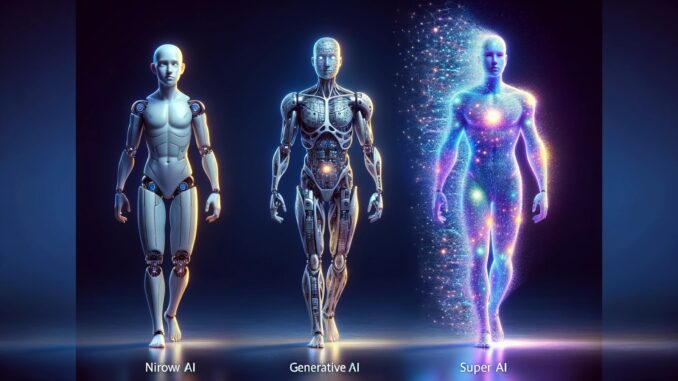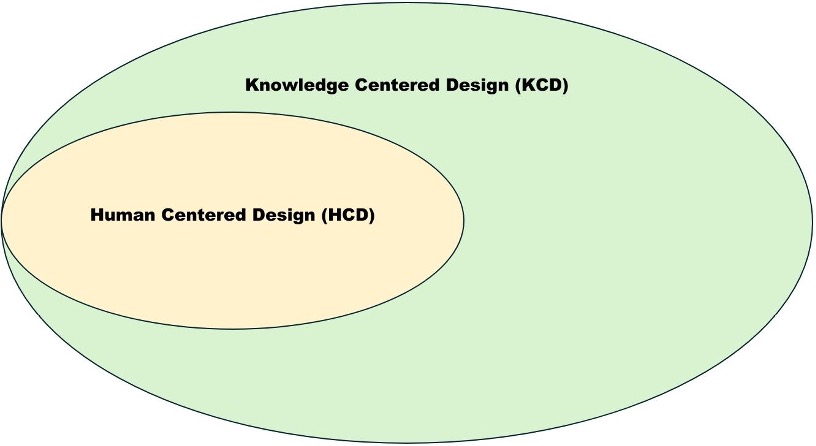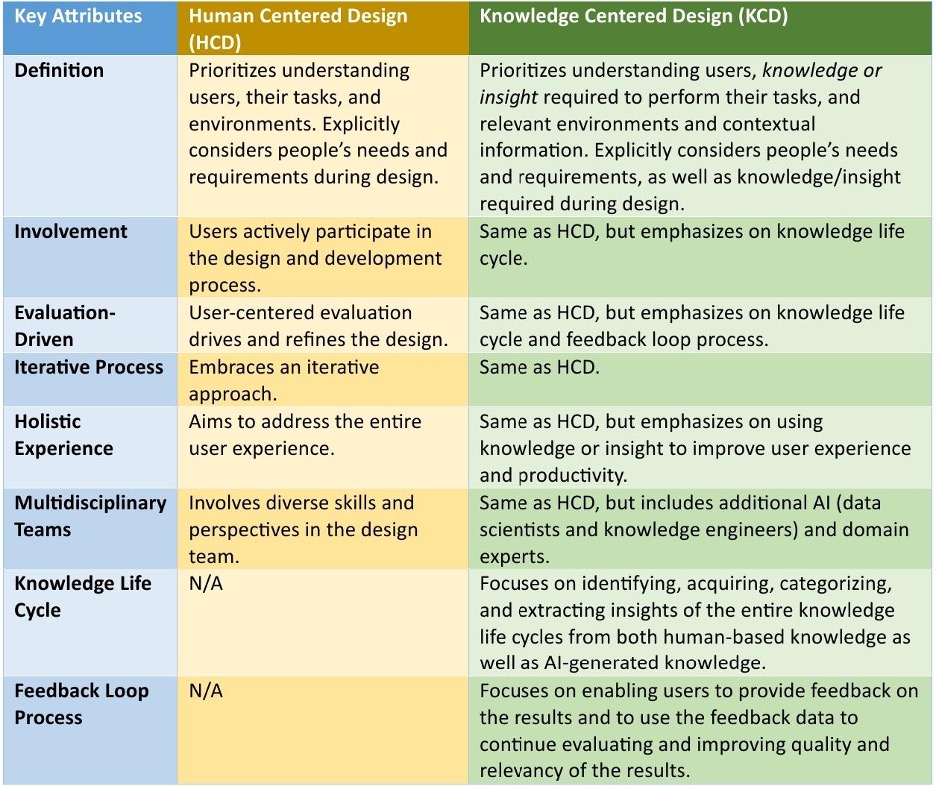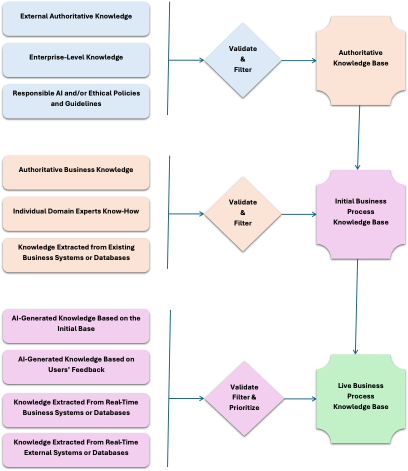
By Walson Lee
Abstract
With the rapid advancement of Generative AI (GenAI)-based solutions, traditional enterprise requirements gathering and design processes may fall short. Enterprises need to adapt to a new set of design and development processes to effectively address GenAI-related challenges. This article proposes a Knowledge-Centered Design (KCD) pattern, an extension of the Human-Centered Design (HCD). KCD emphasizes on various forms of human and enterprise knowledge, such as institutional know-how and intellectual property, in conjunction with artificial knowledge produced by GenAI. To ensure the effectiveness of this proposed KCD design pattern for GenAI-based solutions, we introduce two crucial design concepts: the knowledge life cycle process and the feedback loop process. These concepts aim to enhance the continuous self-learning and improvement of GenAI solutions.
Introduction: Challenges of Designing GenAI-based Enterprise Solutions
Many enterprises are entering the race to build a new class of enterprise solutions based on Generative AI (GenAI) technology. However, GenAI introduces a new set of design challenges that require innovative approaches.
Below is a list of key design challenges:
- Non-deterministic Nature of Large Language Models (LLMs): LLMs can produce different outputs even when given the same input due to their complex neural networks and extensive training data. This non-determinism can foster creativity but also incurs inconsistency, which is problematic in certain enterprise contexts, such as healthcare, where consistency is paramount.
- Acquiring Appropriate Knowledge Content and Relevant Domain Experts: Retrieval-Augmented Generation (RAG) pattern addresses issues like hallucination and outdated knowledge in LLMs by integrating real-time data from authoritative sources. LangChain, a popular LLM framework, can facilitate experimentation and prototyping of custom LLM chains with agents. Nevertheless, the real-world challenge lies in validating these various data sources/knowledge contents, and seamlessly integrating them with LLMs to enhance accuracy and credibility.
- Testing and Measuring Quality and Effectiveness: Key metrics for evaluating GenAI-based solutions include accuracy, reliability, contextual relevance, and scalability. Each poses its own set of implementation challenges; for example, ensuring accuracy requires rigorous testing processes while scalability demands efficient resource management.
- Incorporating User Feedback: User feedback loops are essential for refining GenAI-based solutions. They involve collecting user responses to improve system performance iteratively. Implementing an effective feedback loop requires robust mechanisms for gathering, analyzing, and integrating user insights into the system.
Knowledge Centered Design (KCD) Pattern
The need for a new design pattern, specifically the Knowledge Centered Design (KCD), arises from the evolution and complexity of AI and machine learning technologies. As these technologies advance, they generate an increasing volume of knowledge and insights. The traditional Human-Centered Design (HCD) focuses on understanding users, their tasks, and environments. However, it may not be fully equipped to handle the intricate dynamics of both human-generated and AI-generated knowledge effectively.
The proposed KCD extends HCD by emphasizing the life cycle of knowledge – identifying, acquiring, categorizing, extracting insights – and incorporating feedback loops for continuous improvement. It ensures that both human-based and AI-generated knowledge are effectively integrated into the design process to enhance user experience and productivity.
Figure 1. Relationship between Human Centered Design and Knowledge Centered Design

Here’s a comparison of the two design patterns:

In summary, KCD is a natural extension of HCD that is more suited for Generative AI-based enterprise solutions due to its emphasis on the life cycle of knowledge and continuous improvement through feedback loops. It aims to enhance user experience and productivity by effectively integrating human-based and AI-generated knowledge into the design process.

Knowledge Life Cycle Process
Figure 2. Conceptual Knowledge Life Cycle Process
Figure 2 illustrates the proposed conceptual Knowledge Life Cycle Process.
- Authoritative Knowledge Base: This base comprises major components including:
- External Authoritative Knowledge: Typically includes regulatory requirements and guidelines, such as those regularly published or revised by FDA concerning drug usage policies. Every pharmacy and healthcare provider in the US must comply with these policies and guidelines, a similar standard that extends to many other industries.
- Enterprise-Level Knowledge: Refers to typical enterprise policies, guidelines, and intellectual property (IP). This knowledge is long-term in nature and should be reviewed and updated either annually or semi-annually.
- Responsible AI and/or Ethical Policies and Guidelines: These policies and guidelines can originate from external authoritative organizations, such as the recent EU AI regulatory requirements, or internal enterprise policies. They play a crucial role in filtering AI-generated knowledge and content.
- Initial Business Process Knowledge Base: Established in an early project phase, it consists of:
- Authoritative Enterprise Knowledge Base (all that above)
- Authoritative Business Process Knowledge: Contains business process definitions, business rules, specific business process level IP. It is intermediate-term in nature requiring quarterly or monthly reviews.
- Individual Domain Experts Know-How: A crucial component involving significant time and effort. Many domain experts possess invaluable know-how that is often undocumented but can be captured using advanced AI technologies like NLP, voice, image recognition etc.
- Knowledge Extracted from Existing Business Systems or Databases: These systems often contain valuable insights which can be extracted to enhance the knowledge base.
- Live Business Process Knowledge Base includes:
- The Initial Business Process Knowledge Base (output from above)
- AI-Generated Knowledge Based on the Initial Base: Utilizes RAG pattern for enabling AI to generate additional insights. All generated knowledge must undergo rigorous validation against existing authoritative bases and/or multiple LLMs before incorporation into the live base. It’s critical not to skip the validation and filtering process. This should be an iterative process as the AI-generated knowledge can be carefully incorporated into the live knowledge base once it’s been validated and evaluated.
- AI-Generated Knowledge Based on Users’ Feedback: As highlighted in the KCD approach section, the feedback loop is a crucial factor in improving the quality and relevance of AI solutions.
- Knowledge Extracted From Real-Time Business Systems or Databases: This serves a similar purpose as analyzing historical business data. However, the focus is on identifying real-time patterns, trends, abnormalities, and potential insights to enhance decision-making processes.
- Knowledge Extracted From Real-Time External Systems or Databases: Examples include live data from social networks that offer insights into customer sentiment, or data from well-known external systems, such as financial trading systems or public domain databases. This type of data is instrumental for filtering and evaluation purposes.
Conclusion
The rapid advancement of Generative AI (GenAI) technology presents a unique opportunity for enterprises to gain a competitive edge. However, to fully harness the potential of GenAI, enterprises must adapt their design and development processes to the unique challenges posed by GenAI. The Knowledge-Centered Design (KCD) pattern, as proposed in this article, provides a robust framework for integrating human and enterprise knowledge with artificial intelligence insights.
The knowledge life cycle process, feedback loop process, and integral components of the KCD pattern, serve as starting baselines that each enterprise can adapt and adjust according to their specific business needs and institutional culture. These processes ensure the continuous learning and improvement of GenAI solutions, making them more responsive, adaptive, and effective.
In conclusion, the KCD pattern is not merely an option but a necessity for enterprises aiming to successfully implement GenAI-based solutions. It offers a structured methodology for addressing the non-deterministic nature of Large Language Models, acquiring appropriate knowledge content, testing and measuring the quality and effectiveness of GenAI solutions, and incorporating user feedback. By embracing KCD, enterprises can unlock the full potential of GenAI, paving the way for innovative solutions that can revolutionize their operations and drive their success in the digital age.
References
- Lee, W. (2024, January 29). Harnessing Generative AI in Enterprises: The Dual Power of Knowledge and Prompt Engineering. Harnessing Generative AI in Enterprises: The Dual Power of Knowledge and Prompt Engineering – Architecture & Governance Magazine (architectureandgovernance.com)
- Engelbrecht, S (2023, May 12). Output from AI LLMs is Non-Deterministic. Output from AI LLMs is Non-Deterministic. What that means and why you should care. – Sitation
- Zeichick, A. (2023, September 19). What Is Retrieval-Augmented Generation (RAG)? What Is Retrieval-Augmented Generation (RAG)? (oracle.com)
- Sharma V. (2024, Jan 25). Understanding Retrieval-Augmented Generation (RAG) with Large Language Models (LLMs). Understanding Retrieval-Augmented Generation (RAG) with Large Language Models (LLMs) | by Viraj Sharma | WeTheITGuys | Jan, 2024 | Medium
- Gentile, D. (2023, April 28). Introduction to LangChain: A Framework for LLM Powered Applications. Introduction to LangChain: A Framework for LLM Powered Applications
- Kushal V. (2023, Jun 20). LangChain: A Framework for Harnessing LLM Potential. LangChain: A Framework for Harnessing LLM Potential
- Lp, J. (2024, Jan 22). LLM Evaluation Metrics: Everything You Need for LLM Evaluation. https://www.confident-ai.com/blog/llm-evaluation-metrics-everything-you-need-for-llm-evaluation
- ISO 9241-110 Principles of the Human-Centered Approach (2021). Human Centered Design (HCD) | NIST
- IDEO, Design Kit: The Human-Centered Design Toolkit (2011). Design Kit: The Human-Centered Design Toolkit – IDEO
- Nair P. (2023). Revolutionizing Employee Feedback with Generative AI. Revolutionizing Employee Feedback with Generative AI (leena.ai)
- Yao, Y., Liu J., Ryan C. (2023). Using active learning and an agent-based system to perform interactive knowledge extraction based on the COVID-19 corpus, Cambridge University Press. Using active learning and an agent-based system to perform interactive knowledge extraction based on the COVID-19 corpus | The Knowledge Engineering Review | Cambridge Core
